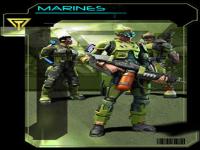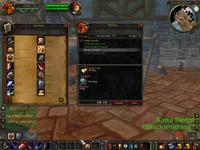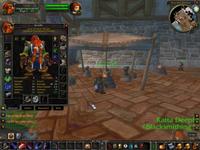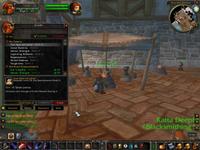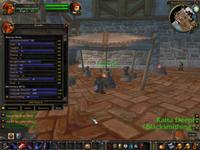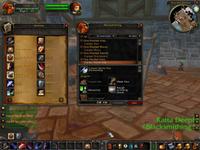|
|
|
Main News Forums Games Games Database Top 100 Release List Support Files Features Reviews Previews Interviews Editorials Diaries Misc Download Gallery Music Screenshots Videos Miscellaneous Staff Members Privacy Statement |
MMORPGDot Feature: World of Warcraft Beta Journal #3
Great gameplay, quality graphics, and compelling storylines can make or break a game. Without interesting things to do in a visually appealing setting for good reasons, games tend to fall on their faces. Beyond that, Interface is probably the biggest hurdle between a good game and a great game. An extremely fun game with a terrible interface will get played just as often as a boring game. With the history Blizzard has for fun gameplay and excellent interface design, it should come as no shock to you that World of Warcraft is a treat to use as well as play. The most enjoyable aspect of this interface is the ease with which you can get into it. Right clicking does the "default" action in most cases. You know what action this will be by hovering your cursor over the object or NPC you wish to interact with. If the icon is a little sword, you can attack them. If it is a little chat box, you talk to them. If it's a dollar sign, they're either a merchant and you can shop with them or you can learn skills from them. Right clicking brings up the appropriate box to do what you need to do with the object/npc. Everyone by now is probably familiar with the quest box. Right clicking on an npc with a yellow exclamation point above their head brings up a quest log entry. Inside this quest log is some text, which is slowly revealed to you at a readable speed. This is a really nice touch as it simulates an actual conversation. Once the quest is revealed, you are usually given an option of rewards or simply informed that you will receive a cash payment. As long as you're doing level appropriate quests the rewards are always appropriate. Even if you're not, the loot that you're given is very sellable and can net you some cash from other players or merchants. Once you've accepted a quest, your quest log (opened by pressing "L") is your catalogue of what you're currently working on. Quests are organized by the location you retrieved them, unless they are class or tradeskill specific quests, in which case they are listed by your class or tradeskill. Quests are colour coded to indicate the level of the reward in relation to your level. If the quest is coloured yellow (which most of them will be), it's going to be a challenge for you and will provide good xp for you. Similarly, red quests are probably too hard for you (but it's unlikely you'd be given a quest that was red, so you'll probably never see one), green quests are providing an xp/loot reward that's slightly below your level, and quests that have grey text are probably not worth doing because the reward is going to be so inferior to what your level demands. Merchants are extremely easy to utilize, as they have screens that look just like your inventory (or backpack, which can be opened by hitting "B"). Small blocks hold items that are for sale, next to which are the prices they'll charge you for the item. Right clicking on an item in the merchant's window purchases one of that item and deposits it into your backpack. You can also left click to pick one up, drag, and drop the item into either your backpack or the appropriate slot on your character sheet. Picking up an item (either from a merchant or your backpack) causes the slot that it can be used in to highlight in yellow. In this way you always know where to place your weapons and armor. Hovering over an item (in either your inventory or a merchant's screen) reveals the info block about the item. On the info-block is revealed the item's name, type, number of hands used to wield it, attack speed (in seconds), damage range, level ranges, and any special properties. If you are currently in a merchant's screen, the item block will also list the amount of money the merchant will pay you. Item level ranges are something that has been mentioned before, but I'll go over it quickly because I've even seen people *in* the Beta asking about it. A weapon (or any item) will usually have a listing something like "Level 25 (min 17)". What this means is that the weapon is best utilized by someone of level 25. IE, the damage it does will be maxed out, all of the bonuses will be active, etc. "min 17" means that it can first be used by someone who is level 17. However, someone using that weapon at level 17 and someone using the weapon at level 25 will be doing hugely different amounts of damage, and not just because of possible higher strength. The closer to the listed level of the item, the more damage you will do, up until the max listed on the item.
Beyond that, Tradeskills are also Abilities...something I'll get to in a moment.
The current push, Tradeskills must be purchased from Tradeskill Trainers before they can be used. In the next push, you're going to be able to obtain a Tradeskill as a matter of course through leveling. Beyond that, new recipes and higher levels of the Tradeskill will still need to be purchased from a Trainer. Tradeskills are broken into two categories: Gathering and Crafting. Most Crafting skills have a Gather skill (Mining/Blacksmithing, for example), and most players that do one also do the other. Like weapon skills, tradeskills improve through use. Unlike other MMOGs, a crafting attempt will always succeed as long as a player has the right ingredients and the recipe. Crafting is done at specific locations, such as anvils. There, the player opens his Tradeskill Ability from the list and uses the Tradeskill window. Listed on the window are all the recipes he currently owns. If he has enough materials to make something, a number is listed next to the recipe name. In the bottom area of the window are a list of the components used in the creation of the item and the requirements to make it. There is also an icon for the item itself, which you can hover over to see what the stats of the item will be. Recipes are colour coded like quests. In this case, the colour indicates the likelihood that you'll increase your blacksmithing skill by using the recipe. If you're simply looking to grind skill levels, just like with quests you want to be doing yellow items. Yellow indicates that you are likely to increase your skill with the item.
One last quick aside before I wrap it up today (whew). A reader wrote in to ask if I could quickly compare World of Warcraft to some currently available Massively Multiplayer games, with Everquest being the one specifically mentioned. I should point out that WoW is still in Beta test. Everything about it is still in flux, so anything I say today is basically going to be invalid in two months. Just the same, you ask and I write, so here is my bullet point comparison of WoW to two other great fantasy MMOGs, Final Fantasy XI and Everquest:
On Thursday I'm going to relate to you a tale of adventure, looting, discovery, and death. On Thursday: The Deadmines of Westfall. See you then!
Average Reader Ratings: 7 (45 votes) |
|||||||||
|
All original content of this site is copyrighted by RPGWatch. Copying or reproducing of any part of this site is strictly prohibited. Taking anything from this site without authorisation will be considered stealing and we'll be forced to visit you and jump on your legs until you give it back. |
||




